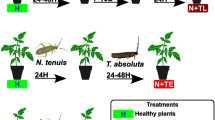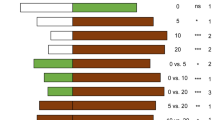Abstract
We studied the induced response of tomato plants to the green strain and the red strain of the spider mite Tetranychus urticae. We focused on the olfactory response of the predatory mite Phytoseiulus persimilis to volatiles from T. urticae-infested tomato leaves in a Y-tube olfactometer. Tomato leaves attracted the predatory mites when slightly infested with the red strain, or moderately or heavily infested with the green strain. In contrast, neither leaves that were slightly infested with green-strain mites, nor leaves that were moderately or heavily infested with the red strain attracted the predators. We discuss the specific defensive responses of tomato plants to each of the two strains.
Similar content being viewed by others
References
Aina, O.J., Rodriguez, J.G. and Knavel, D.E. 1972. Characterizing resistance to Tetranychus urticae in tomato. J. Econ. Entomol. 65: 641–643.
Alborn, H.T., Turlings, T.C.J., Jones, T.H., Stenhagen, G., Loughrin J.H. and Tumlinson, J.H. 1997. An elicitor of plant volatiles from beet armyworm oral secretion. Science 276: 945–949.
Berlinger, M.J., Beke Lok-van Dijk, Dahan, R., Lebiush-Mordechai, S. and Taylor, E.A.J. 1996. Indicator plants for monitoring pest population growth. Ann. Entomol. Soc. Am. 89: 611–622.
Chatzivasileiadis, E.A. and Sabelis, M.W. 1997. Toxicity of methyl ketones from tomato trichomes to Tetranychus urticae Koch. Exp. Appl. Acarol. 21: 473–484.
Chatzivasileiadis, E.A. and Sabelis, M.W. 1998. Variability in susceptibility among cucumber and tomato strains of Tetranychus urticae Koch to 2-tridecanone from tomato trichomes: effects of host plant shift. Exp. Appl. Acarol. 22: 455–466.
De Boer, R. 1982. Genetic affinities between spider mite Tetranychus urticae populations in a non-agricultural area II. Entomol. Exp. Appl. 28: 22–28.
Dicke, M., Takabayashi, J., Posthumus, M.A., Schuette, C. and Krips, O.E. 1998. Plantphytoseiid interactions mediated by herbivore-induced plant volatiles: variation in production of cues and in response of predatory mites. Exp. Appl. Acarol. 22: 311–333.
Dupont, L.M. 1979. On the gene flow between Tetranychus urticae Koch, 1936 and Tetranychus cinnabarinus (Boisducal) Boudreaux, 1956 (Acari: Tetranychidae): synonymy between the two species. Entomol. Exp. Appl. 25: 297–303.
Drukker, B., Janssen, A., Ravensberg, W. and Sabelis, M.W. 1997. Improved control capacity of the mite predator Phytoseiulus persimilis (Acari: Phytoseiidae) on tomato. Exp. Appl. Acarol. 21: 507–518.
Ehara, S. 1989. Recent advances in taxonomy of Japanese Tetranychid mites. Shokubutuboeki 43: 358–361. (in Japanese)
Mattiacci, L., Dicke, M. and Posthumus, M. A. 1995. b-Glucosidase: an elicitor of herbivoreinduced plant odour that attracts host-searching parasitic wasps. Proc. Natl. Acad. Sci. 92: 2036–2040.
Rodriguez, J.G., Knavel, D.E. and Aina, O.J. 1972. Studies in the resistance of tomatoes to mites. J. Econ. Entomol. 65: 50–53.
Takabayashi J. and Dicke, M. 1992. Response of predatory mites with different rearing histories to volatiles of uninfested plants. Entomol. Exp. Appl. 64: 187–193.
Takabayashi, J. and Dicke, M. 1993. Volatile allelochemicals that mediate interactions in a tritrophic system consisting of predatory mites, spider mites and plants. In: Mutualism and Community Organization. Behavioural, Theoretical and Food-web Approaches, H. Kawanabe, J.E. Cohen and K. Iwasaki (eds), pp. 280–295, Oxford University Press.
Takabayashi, J., Dicke, M. and Posthumus, M.A. 1994. Volatile herbivore-induced terpenoids in plant-mite interactions: variation caused by biotic and abiotic factors. J. Chem. Ecol. 20: 1329–1354.
Takabayashi, J., Takahashi, S., Dicke, M. and Posthumus, M.A. 1995. Developmental stage of herbivore Pseudaletia separata affects production of herbivore-induced synomone by corn plants. J. Chem. Ecol. 21: 273–287.
Tomczyk, A. and Kropczynska, D. 1985. Effect of the host plants. In: Spider mites. Their Biology, Natural Enemies and Control, W. Helle and M.W. Sabelis (eds), pp. 317–329, Elsevier.
Van Haren, R.J.F., Steenhuis, M.M., Sabelis, M.W. and de Ponti, O.M.B. 1987. Tomato stem trichomes and dispersal success of Phytoseiulus persimilis relative to its prey Tetranychus urticae. Exp. Appl. Acarol. 3: 115–121.
Yano, S., Wakabayashi, M., Takabayashi, J. and Takafuji, A. 1998. Factors determining the host plant range of the phytophagous mite, Tetranychus urticae (Acari: Tetranychidae): a method for quantifying host plant acceptance. Exp. Appl. Acarol. 22: 595–601.
Author information
Authors and Affiliations
Rights and permissions
About this article
Cite this article
Takabayashi, J., Shimoda, T., Dicke, M. et al. Induced Response of Tomato Plants to Injury by Green and Red Strains of Tetranychus Urticae. Exp Appl Acarol 24, 377–383 (2000). https://doi.org/10.1023/A:1006497024175
Issue Date:
DOI: https://doi.org/10.1023/A:1006497024175




